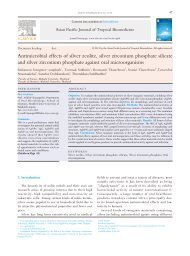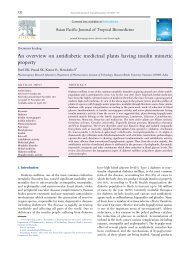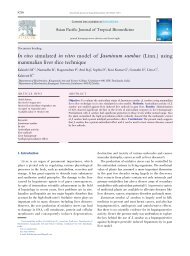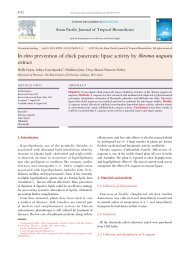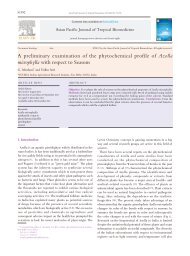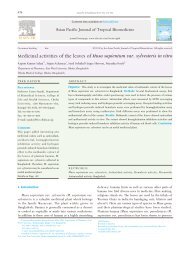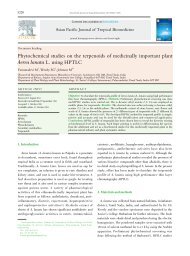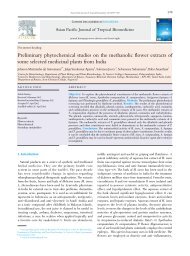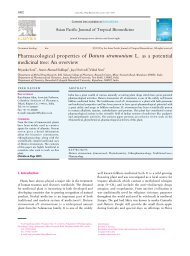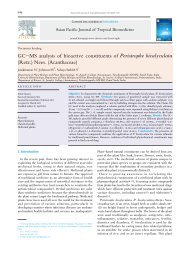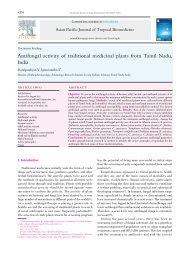Larvicidal and repellent potential of Moringa oleifera ... - Apjtb.com
Larvicidal and repellent potential of Moringa oleifera ... - Apjtb.com
Larvicidal and repellent potential of Moringa oleifera ... - Apjtb.com
You also want an ePaper? Increase the reach of your titles
YUMPU automatically turns print PDFs into web optimized ePapers that Google loves.
126<br />
The experiments were conducted in a glass chamber <strong>of</strong><br />
140 cm 暳 120 cm 暳 60 cm. A window <strong>of</strong> 60 cm 暳 30 cm was<br />
situated at mid bottom <strong>of</strong> one side <strong>of</strong> the chamber. Hundred<br />
<strong>of</strong> three or four days' old blood starved adult female<br />
mosquitoes, fed with sucrose solution, were released into<br />
the chamber. A belly shaven pigeon was kept tied inside the<br />
cage in immobilized condition. The experimental chamber<br />
was tightly closed. The experiment was repeated five times<br />
on separate days, including control mosquitoes <strong>of</strong> the<br />
same age groups. The data were pooled <strong>and</strong> average values<br />
were subsequently used for calculations. Controls were<br />
maintained in two sets. One set was run with coil lacking the<br />
active ingredient <strong>of</strong> plant powder (control I), the other was a<br />
<strong>com</strong>mercial coil (Mortein coil) which was used for positive<br />
control to <strong>com</strong>pare the effectiveness <strong>of</strong> plant coils. After the<br />
experiment over fed <strong>and</strong> unfed (active <strong>and</strong> dead) mosquitoes<br />
were counted.<br />
The protection given by the smoke from plant samples<br />
against the biting <strong>of</strong> adult mosquito was calculated in terms<br />
<strong>of</strong> percentage <strong>of</strong> unfed mosquitoes due to treatment.<br />
No. <strong>of</strong> unfed mosquitoes in treatment -<br />
No. <strong>of</strong> unfed mosquito in control I<br />
% Protection= 暳 100<br />
No. <strong>of</strong> mosquitoes treated<br />
2.6. Field trial<br />
For the field trial study, mosquito breeding sites were at<br />
the endemic districts <strong>of</strong> Tamil Nadu. The field trials were<br />
conducted by using required concentration <strong>of</strong> plant extracts<br />
<strong>and</strong> bacterial pesticide in different breeding habitat, such as<br />
overhead tank, cement tank <strong>and</strong> cement container. Selection<br />
<strong>of</strong> the localities was decided on the basis <strong>of</strong> the breeding<br />
<strong>potential</strong> <strong>and</strong> operational convenience. Field application <strong>of</strong><br />
the plant extracts <strong>and</strong> bacterial pesticides was done with the<br />
help <strong>of</strong> a knapsack sprayer (or) h<strong>and</strong> sprayer. Biopesticide<br />
was sprayed uniformly on the surface <strong>of</strong> the water in each<br />
habitat. The mean larval density was calculated on the<br />
basis <strong>of</strong> 5 dips per each habitat. Prior to the experiment the<br />
surface area <strong>of</strong> the breeding habitat was measured along<br />
with the pre-spray density <strong>of</strong> larvae. 24 h after the treatment<br />
the post-spray density <strong>of</strong> larvae was recorded. Successive<br />
observations were made at an interval <strong>of</strong> one day. The<br />
percentage reduction was calculated by the following<br />
formula [7].<br />
% reduction=100 - (C 1 / T 1 暳 T 2 / C 2)<br />
Where, C 1 <strong>and</strong> T 1 are pre-treatment density <strong>and</strong> T 2 <strong>and</strong><br />
C 2 are the post-treatment density <strong>of</strong> larvae per dip in the<br />
control <strong>and</strong> treated habitats, respectively.<br />
2.7. Statistical analysis<br />
The mortality observed (ppm) was corrected using Abbott's<br />
K. Prabhu et al./Asian Pacific Journal <strong>of</strong> Tropical Biomedicine (2011)124-129<br />
formula during the observation <strong>of</strong> the larvicidal <strong>potential</strong>ity<br />
<strong>of</strong> the plant extracts. Statistical analysis <strong>of</strong> the experimental<br />
data was performed using the <strong>com</strong>puter s<strong>of</strong>tware SPSS 14<br />
version <strong>and</strong> MS EXCEL 2003 to find the LC 50, regression<br />
equations (Y = mortality; X = concentrations) <strong>and</strong> regression<br />
coefficient values.<br />
3. Results<br />
The results <strong>of</strong> larvicidal <strong>and</strong> pupicidal activity <strong>of</strong> M.<br />
<strong>oleifera</strong> were presented in Figure 1. The plant extract<br />
exhibited larvicidal activities on different instars (I, II, III <strong>and</strong><br />
IV) <strong>and</strong> pupa <strong>of</strong> An. stephensi. The LC 50 <strong>and</strong> LC 90 values <strong>of</strong> M.<br />
<strong>oleifera</strong> for I instar larvae were 57.79 ppm <strong>and</strong> 125.93 ppm,<br />
II instar 63.90 ppm <strong>and</strong> 133.07 ppm, III instar 72.45 ppm <strong>and</strong><br />
139.82 ppm, IV instar 78.93 ppm <strong>and</strong> 143.20 ppm, respectively.<br />
The LC 50 <strong>and</strong> LC 90 values <strong>of</strong> M. <strong>oleifera</strong> for pupa were 67.77<br />
ppm <strong>and</strong> 141.00 ppm. The regression equation values <strong>of</strong> M.<br />
<strong>oleifera</strong> for I instar larvae were Y= -1.087 01 + 0.018 81X,<br />
II instar Y= 0-1.184 07 + 0.018 53X, III instar Y= -1.378 29 +<br />
0.019 02X <strong>and</strong> IV instar Y= -1.574 0 + 0.019 94X, respectively.<br />
The regression equation values <strong>of</strong> pupae were Y= -1.186 04<br />
+ 0.017 50X. The LC 50 <strong>and</strong> LC 90 values <strong>of</strong> pupae were 6.792%,<br />
5.449% <strong>and</strong> 16.925%, 15.474%. Among the different larval<br />
stages, the I instar larvae were more susceptible than the<br />
other instar larvae. The plant extract showed considerable<br />
larval <strong>and</strong> pupal mortality. The Chi-square values were<br />
significant at P0.05%).<br />
Table 2 showed the <strong>repellent</strong> activity <strong>of</strong> M. <strong>oleifera</strong> against<br />
An. stenphensi <strong>and</strong> it was does dependent. Repellency<br />
was increased after the does increased. For example<br />
90.41% repellency was noted at 100% concentration <strong>and</strong><br />
23.28% repellency was reduced after the treatment <strong>of</strong> 20%<br />
concentration. The <strong>repellent</strong> activity was carried out in<br />
the evening from 5.00 -10.00 pm. The repellency was low<br />
at 20% concentration whereas it has been increased at<br />
100% concentration. An average production was at 60%<br />
concentration which could make 58.90% production against<br />
An. stephensi.



